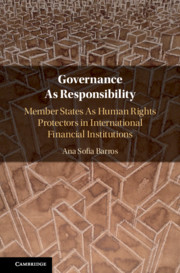 Governance As Responsibility
Governance As Responsibility Published online by Cambridge University Press: 28 June 2019
Chapter I discusses the relationship between international organisations and their member States and how both entities operate as international legal subjects. Looking underneath the veil of the legal personality of international organisations, it demonstrates that member States remain powerful actors in their own right, which has obvious implications for the application of international responsibility rules. With a focus on international financial institutions, the chapter begins by analysing the impact of State adhesion to international organisations, first from a domestic law perspective, and then from the viewpoint of international law, to highlight the notion that member States are continuously engaged in the exercise of the powers that they transferred to international organisations. Subsequently, and in order to clarify the borderline between both legal subjects, the chapter concentrates on the international legal personality of international organisations and how their legal distinctness comes about. It does so by exploring the concept of institutional autonomy. Against this backdrop, the chapter finalizes by shedding light into the elements that define member State conduct as subjects of international law. As the chapter concludes, such visibility is linked to the governance role of member States as ‘authority managers’ in international organisations.
To save this book to your Kindle, first ensure no-reply@cambridge.org is added to your Approved Personal Document E-mail List under your Personal Document Settings on the Manage Your Content and Devices page of your Amazon account. Then enter the ‘name’ part of your Kindle email address below. Find out more about saving to your Kindle.
Note you can select to save to either the @free.kindle.com or @kindle.com variations. ‘@free.kindle.com’ emails are free but can only be saved to your device when it is connected to wi-fi. ‘@kindle.com’ emails can be delivered even when you are not connected to wi-fi, but note that service fees apply.
Find out more about the Kindle Personal Document Service.
To save content items to your account, please confirm that you agree to abide by our usage policies. If this is the first time you use this feature, you will be asked to authorise Cambridge Core to connect with your account. Find out more about saving content to Dropbox.
To save content items to your account, please confirm that you agree to abide by our usage policies. If this is the first time you use this feature, you will be asked to authorise Cambridge Core to connect with your account. Find out more about saving content to Google Drive.